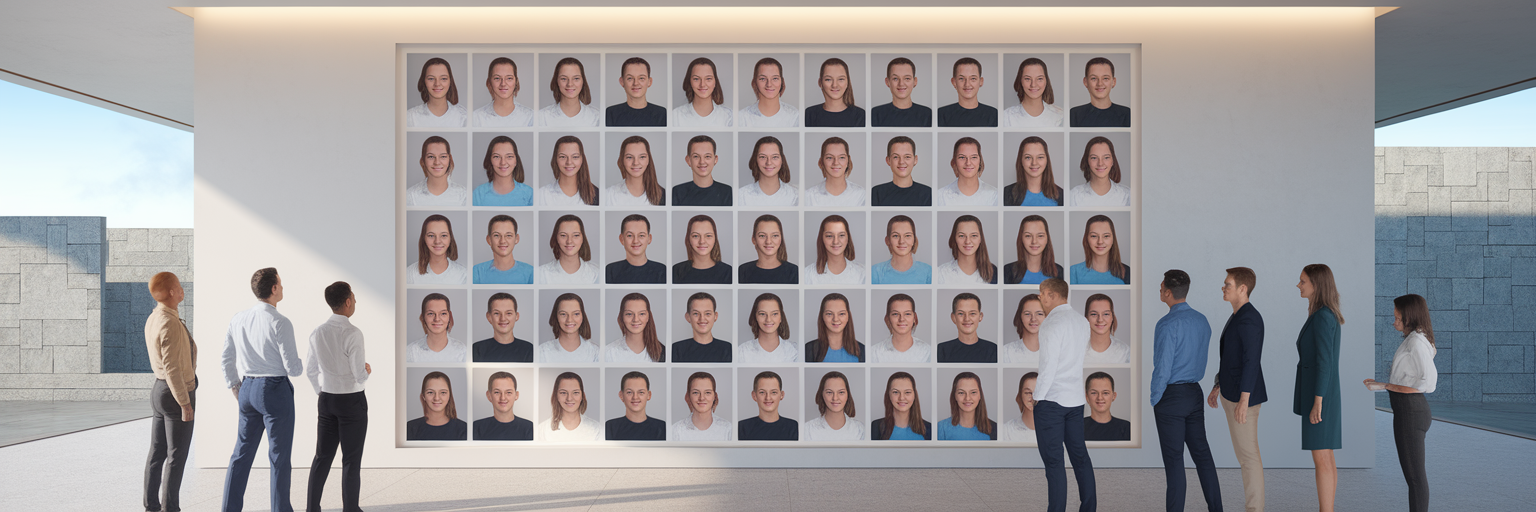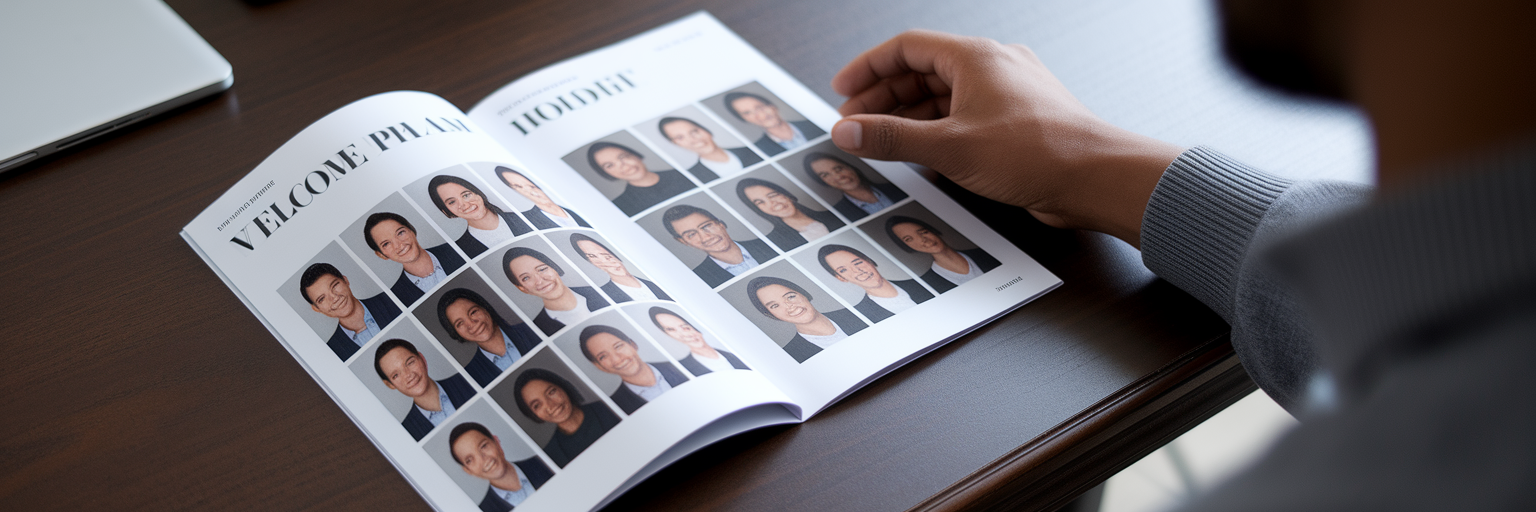The Visual Disconnect in a Distributed Workforce
Since 2019, the number of people working primarily from home has more than tripled, yet the way companies visually represent their teams has barely changed. We have all seen it. The company ‘About Us’ page that looks more like a random collection of photos than a unified team. You have the CEO’s professionally shot photo from five years ago, a developer’s blurry webcam still, and a marketer’s selfie from a weekend trip.
This visual chaos does more than just look unprofessional. For potential clients or investors, it subconsciously signals disorganization. It raises a quiet question: if they cannot align on something as simple as photos, how well do they manage complex projects? Internally, this inconsistency gets in the way of creating a shared identity, which is a cornerstone for building trust in remote teams. When team members only see each other as pixelated images or mismatched avatars, it creates a subtle distance.
Of course, organizing a traditional photoshoot for a team spread across different cities, or even continents, is a logistical and financial puzzle. The costs of hiring photographers in multiple locations, coordinating schedules across time zones, and ensuring a consistent style are immense. This old method simply does not fit with the agile, distributed nature of modern business. The problem is clear, a scattered team often looks exactly like that, scattered.
Forging a Unified Professional Front with AI

That visual disconnect we just talked about has a modern answer. An AI professional photo generator steps in to solve the exact problem of presenting a scattered team as a cohesive unit. The technology is straightforward. Team members upload a handful of their own casual photos, and the AI engine gets to work, producing studio-quality, professional headshots that all share a consistent look and feel.
The real power here is in achieving consistent team branding at scale. Imagine every employee’s headshot on the company website, their LinkedIn profile, and in sales proposals sharing the same background color, lighting style, and professional tone. This uniformity instantly communicates a polished and organized corporate identity. It tells the world that this is a team that is aligned and professional, no matter where each member is located.
Beyond the external perception, there is a significant internal benefit. When employees see themselves as part of a visually unified gallery, it reinforces a sense of belonging and shared purpose. It is a small but powerful way to bridge the physical distance that defines remote work. Seeing a colleague’s clear, professional photo in an email or a chat window makes interactions feel more human. For organizations looking to present a strong, unified front, our enterprise solutions offer a streamlined way to manage this process for the entire company.
The Authenticity Debate: Balancing Polish with Personality
Let’s address the main question that comes up with AI-generated images: the risk of looking too perfect or artificial. It is a valid concern. As Headshots.com notes in a recent article, some AI outputs can look "tacky" if not done right. Authenticity is the foundation of genuine workplace relationships, and a headshot that feels fake can create a barrier, making it harder for colleagues to connect on a human level.
The goal is not to create an idealized avatar but to produce an authentic yet professional version of each person. So, how do you find that balance? The key is to approach AI headshots for remote teams with intention and human judgment. Here are a few strategies to guide the process:
- Explore a wide range of styles. Choose an AI platform that offers diverse customization options. This allows teams to select a look that enhances their professionalism while staying true to their company culture, whether it is formal and corporate or modern and creative.
- Preserve natural features and personality. Encourage team members to select styles that reflect who they are. The best AI headshots maintain the individual’s unique facial structure and expression. It is about looking like the best version of yourself on a good day, not like someone else entirely. You can learn more by reviewing these common professional headshot mistakes.
- Avoid overly airbrushed or generic looks. Steer clear of styles that erase skin texture or create a plastic-like finish. A little character in a photo is what makes it feel real and approachable. As highlighted in a LinkedIn post by Mitch King, generating consistent backgrounds and styles is crucial for brand cohesion without sacrificing individuality.
Finding the right balance is critical. The table below shows the subtle but important differences to look for.
| Characteristic | Overly-Processed AI Headshot | Authentic-Professional AI Headshot |
|---|---|---|
| Skin Texture | Flawless, plastic-like, no pores | Natural skin texture is preserved |
| Facial Features | Slightly altered or overly symmetric | Recognizably the individual's features |
| Expression | Generic, vacant smile | Shows genuine personality and warmth |
| Overall Feel | Artificial, disconnected, 'uncanny valley' | Polished, professional, and approachable |
Note: This table illustrates the subtle but critical differences between AI outputs. The goal is to guide users toward settings and styles that enhance rather than erase individuality, which is crucial for building trust in remote teams.
Beyond Aesthetics: Headshots as a Collaboration Catalyst

The impact of unified headshots goes far beyond just looking good on a website. The process itself can become a modern team-building activity, sparking conversations and creating a shared experience. But the real change happens in the day-to-day workflow, where these images act as a catalyst for better collaboration.
High-quality, consistent headshots humanize the digital tools we rely on every day. A recent study from ScienceDirect found that incorporating AI can significantly improve task performance in creative and supportive work, and this humanizing element is a part of that equation. Here is how it plays out:
- In virtual team collaboration tools like Slack or Asana, seeing a clear, professional face next to a name makes interactions feel more personal and less transactional.
- In email signatures, a professional headshot adds a human touch, reminding the recipient that there is a real person on the other side of the screen.
- On internal directories, it helps new hires quickly put faces to names, making them feel part of the team faster and accelerating their integration.
Furthermore, by providing professional team headshots online, AI solutions eliminate the logistical headaches of traditional photoshoots. This frees up valuable time and resources, allowing leaders and their teams to focus on strategic initiatives instead of coordinating photographers. When you improve team dynamics and collaboration, you are not just improving morale, you are improving the business itself. Exploring solutions designed specifically for improving team cohesion can make this process even more effective.
Implementing AI Headshots for Maximum Impact
Rolling out new team headshots should be a strategic initiative, not just an administrative task. To get the most out of the change, a thoughtful implementation plan is essential. Here is a simple, step-by-step guide for managers and founders.
First, leadership needs to define the company’s visual brand standard. This means agreeing on the desired background, tone, and overall style before inviting the team. This ensures the final result is cohesive and aligned with the company’s identity. Next, communicate the initiative to the team. Frame it as a benefit that enhances both their personal professional brand and the company’s image, not as a mandatory chore.
The third step is crucial: a simultaneous rollout. To achieve the full impact of a unified look, the new headshots should be deployed across all platforms at once. This includes the public website, internal tools, email signatures, and social media profiles. This coordinated update makes a strong statement about the company’s unity and attention to detail. For larger organizations, using a centralized dashboard to manage invites and ensure brand alignment at scale is invaluable. You can explore how these features work by checking out our detailed team guides.
By following these steps, you can transform what might seem like a small update into a powerful tool for strengthening your team and your brand. It is a simple, effective way to show the world, and your own team, that you are united and ready for anything. See for yourself how our platform makes it happen.


